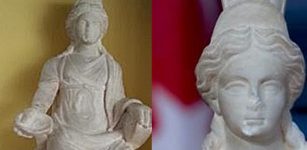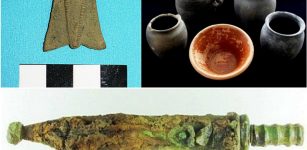Evil Spirits And Demons Of Marshes And Swamps In Slavic Folklore
A. Sutherland - AncientPages.com - In our ancestors' consciousness, shaped by legends and myths, marshes and other wetlands were considered elusive and unpredictable places of evil and dark forces.
 Image source
Image source
People believed that the depths of marshes - enveloped in mist and brightened only by moonlight - were places inhabited by evil spirits waiting for hunters and travelers to lure them into a marsh, causing cause trouble and even death.
One such spirit is the master of marshes, Bolotnik, usually depicted as a man or an older man covered with dirt, algae, and fish scales. In some legends, he is said to have long arms and a tail.
He would appear to people as a bellied, naked man with frog's arms, bug-eyed, largemouth, and long beard. Sometimes, he pretends to be an older man; he can also alter his appearance to be a stepping stone in a marsh or shallow water that helps to cross dangerous areas.
An illustration - Vodyanoy, the Water Sprite Ivan Bilibin, 1934 - Public Domain
If you step on such stone (Bolotnik), he slips away under your feet, and you fall into the thick waters of the marshes up to his neck. You are doomed.
Bolotnik likes to attract people to their deaths, and he makes it easy because marshes are very deceptive; in one moment, they appear safe, and suddenly, they become deadly traps. It is Bolotnik - master of marshes - that creates these traps for all living creatures.
The marshes are most deadly in the evening and at night, and it is said that the spirits of the marshes are most active at this time of day. Bolotnik does not like loud sounds, so it is wise to be quiet when passing through marshes.
Bolotnik's companion is his wife, Bolotnitsa, who changes her appearance depending on circumstances. As a beautiful water maiden, she can attract people passing by and entering the marshes.
Pretending to be lost, she uses her beauty and trickery; by crying and asking to be let out of the forest, she lures a person into the marsh. She is considered the most beautiful maiden of all Slavic mythology, and it is almost impossible to distinguish Bolotnitsa from a naturally beautiful maiden.
Forest swamp. Image credit: Arkhip Kuindzhi (1841–1910) - Kursk State Art Gallery - Public Domain
The only perceptible difference is that Bolotnitsa always sits with legs and feet hidden beneath her, trying to conceal her frog-like feet.
In Slavic mythology, Dziwozona, also known as Mamuna, is a notable figure among the evil spirits that inhabit marshlands. This female swamp demon is traditionally depicted as cruel and dangerous. She often takes the form of an unattractive older woman with a hairy body. A distinctive feature of her appearance is a red hat adorned with a fern twig on her head.
The creature was said to kidnap human babies just after they were born and replace them with her children - changelings - with disproportionate bodies with specific disabilities like large or tiny heads, a huge abdomen, a hairy body, and long claws.
The ancient Slavs held a fascinating belief that to safeguard a child from the malevolent Dziwozona, certain protective measures were necessary. A mother would tie a red ribbon around the child's hand or place a red hat on its head, shielding its face from moonlight.
This intriguing custom endures in some parts of Poland today, reflecting the enduring cultural significance and deep-rooted traditions that continue to shape our understanding of protection and folklore.
In case Dziwozona managed to kidnap a baby away, the mother who lost her child had to take the changeling to a midden, whip it with a birch twig, and pour over it water from an eggshell, shouting, "Take yours, give mine back!". At that point, Dziwozona usually felt sorry for her offspring and took it away, returning the one she stole.
Written By A. Sutherland - AncientPages.com Staff Writer
Updated on Nov 3, 2024
Copyright © AncientPages.com All rights reserved. This material may not be published, broadcast, rewritten or redistributed in whole or part without the express written permission of AncientPages.com
Expand for referencesReferences:
D. Kushnir, Creatures of Slavic myth
A. Gieysztor, Mitologia Słowian
More From Ancient Pages
-
 Fascinating Slavic Mythology Offers Surprising Insight Into The Mystery Of Reincarnation
Featured Stories | Oct 13, 2015
Fascinating Slavic Mythology Offers Surprising Insight Into The Mystery Of Reincarnation
Featured Stories | Oct 13, 2015 -
 Statue Of Goddess Cybele Looted In The 1960s Returned To Turkey
Artifacts | Dec 22, 2020
Statue Of Goddess Cybele Looted In The 1960s Returned To Turkey
Artifacts | Dec 22, 2020 -
 Neanderthals In Swabian Jura Used Complex Tool-Making Techniques 45,000 Years Ago
Archaeology | Sep 8, 2021
Neanderthals In Swabian Jura Used Complex Tool-Making Techniques 45,000 Years Ago
Archaeology | Sep 8, 2021 -
 Gravitational Waves Shed Light On The Mysterious Antikythera Mechanism
News | Jun 29, 2024
Gravitational Waves Shed Light On The Mysterious Antikythera Mechanism
News | Jun 29, 2024 -
 Another 2,000-Year-Old ‘Snack Bar’ Discovered In Pompeii
Archaeology | Apr 10, 2019
Another 2,000-Year-Old ‘Snack Bar’ Discovered In Pompeii
Archaeology | Apr 10, 2019 -
 Bizarre Sandstone Towers Of The Rocky Town And Legend Of Jan Svatos Who Mastered Magic
Featured Stories | Sep 8, 2018
Bizarre Sandstone Towers Of The Rocky Town And Legend Of Jan Svatos Who Mastered Magic
Featured Stories | Sep 8, 2018 -
 Native American Sun Dance: Important Ceremony Of The Plains Indians Of North America
Ancient History Facts | May 20, 2016
Native American Sun Dance: Important Ceremony Of The Plains Indians Of North America
Ancient History Facts | May 20, 2016 -
 Urartian Noble Woman Buried With Jewelry Found In 2,750-Year-Old Necropolis Of Çavuştepe Castle
Archaeology | Sep 10, 2020
Urartian Noble Woman Buried With Jewelry Found In 2,750-Year-Old Necropolis Of Çavuştepe Castle
Archaeology | Sep 10, 2020 -
 Ancient Tombs Of The Nobles In The Valley Of The Queens
Featured Stories | Oct 23, 2016
Ancient Tombs Of The Nobles In The Valley Of The Queens
Featured Stories | Oct 23, 2016 -
 Pregnant Woman’s Remains With An 8-Month Fetus Unearthed At Ancient Taosibei Cemetery, Shanxi, China
Archaeology | Jun 13, 2022
Pregnant Woman’s Remains With An 8-Month Fetus Unearthed At Ancient Taosibei Cemetery, Shanxi, China
Archaeology | Jun 13, 2022 -
 Has a 2,000 Year Old Podium Been Found in the City of David?
Civilizations | Sep 2, 2015
Has a 2,000 Year Old Podium Been Found in the City of David?
Civilizations | Sep 2, 2015 -
 Mischievous Irish Pooka, Shapeshifter And Prankster Has Its Counterparts
Featured Stories | Mar 15, 2018
Mischievous Irish Pooka, Shapeshifter And Prankster Has Its Counterparts
Featured Stories | Mar 15, 2018 -
 Submerged Roman Villa Discovered On The Coast Of Cerveteri, Italy
Archaeology | Jun 6, 2024
Submerged Roman Villa Discovered On The Coast Of Cerveteri, Italy
Archaeology | Jun 6, 2024 -
 Delphic Mysteries – Unusual Prophecy And Birth – Part 1
Ancient Mysteries | Mar 27, 2023
Delphic Mysteries – Unusual Prophecy And Birth – Part 1
Ancient Mysteries | Mar 27, 2023 -
 Wreckage of The French Steamship That Sank In Atlantic In 1856 Found Off The Coast Of Massachusetts
Underwater Discoveries | Sep 23, 2024
Wreckage of The French Steamship That Sank In Atlantic In 1856 Found Off The Coast Of Massachusetts
Underwater Discoveries | Sep 23, 2024 -
 ‘Armenian Stonehenge’: 30 Unknown Stones In Carahunge Complex – Surveyed
Archaeology | Aug 12, 2020
‘Armenian Stonehenge’: 30 Unknown Stones In Carahunge Complex – Surveyed
Archaeology | Aug 12, 2020 -
 Whose Ancient Burials Are Hidden Inside The Vatican City’s Walls?
Archaeology | Mar 11, 2021
Whose Ancient Burials Are Hidden Inside The Vatican City’s Walls?
Archaeology | Mar 11, 2021 -
 Rare Roman Brooch And A Miniature Sword – Unearthed
Artifacts | Jan 18, 2016
Rare Roman Brooch And A Miniature Sword – Unearthed
Artifacts | Jan 18, 2016 -
 Kofun: Megalithic Keyhole-Shaped Tombs That Belonged To High Status People In Japan
Civilizations | Oct 31, 2018
Kofun: Megalithic Keyhole-Shaped Tombs That Belonged To High Status People In Japan
Civilizations | Oct 31, 2018 -
 On This Day In History: Attila The Hun Captures The City of Metz – On Apr 7, 451
News | Apr 7, 2017
On This Day In History: Attila The Hun Captures The City of Metz – On Apr 7, 451
News | Apr 7, 2017


